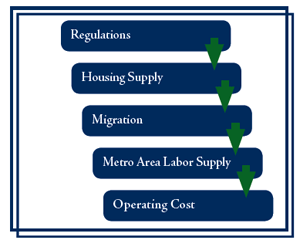September 2009
In this Issue
Flexibility in Combating Homelessness
Development Regulations: How Do They Affect the Local Labor Supply?
Mortgage Insurance Facilitates Affordable Financing
HUD Field Economists Keep Tabs on U.S. Housing Markets
In the next issue of ResearchWorks
Development Regulations: How Do They Affect the Local Labor Supply?
Although scholars and practitioners have explored the effects of regulations on housing supply, few have examined how development regulations, which tend to reduce the supply of housing and increase its cost, also slow economic growth and affect the ability of employers to recruit and retain employees.
In A Review of Regulatory Barriers to Employer Ability to Recruit and Retain Employees, Carliner et al., a team of analysts from Newport Partners, LLC; Abt Associates; and the Joint Center for Housing Studies, examine the relevant literature to answer this question and develop guidance for future research.1 The study is a broad exploration of development regulations and their possible effects on businesses, labor markets, business location decisions, the local mix of industries, employee productivity, the relative economic competitiveness of different metropolitan areas, and other concerns.

Summarizing this research, the authors provide a conceptual framework for thinking about how development regulations — intended to govern residential construction — might produce secondary impacts on labor supply and demand.2 In general, a jurisdiction's tightening of housing regulations leads to restrictions on development. This is often a response to a spurt in local development, which in itself may be a response to an increased in-migration of workers drawn by a rising local demand for labor. This regulatory-induced contraction in housing supply raises home prices (and may increase commuting time, which is often included in a calculus of housing costs), discouraging the incoming migration of workers to join the metro area labor supply. Because workers have to be concerned about real wages (i.e., wages adjusted for the cost of living, including housing costs), any contraction in housing supply drives up wages and, in turn, employers' operating costs (see fig. 1).
Scholars have long known that the cost of housing disproportionately affects the migration of less educated, less-skilled, and lower-paid workers. Therefore, businesses that employ lower-paid workers are more vulnerable to housing supply problems. More highly skilled, better-paid workers tend to be relatively insulated against housing price rises. Housing supply and cost issues have greater effects on potential in-migrants, who generally fill most of the new jobs in a locality, than on workers who already live in the area.

Earlier empirical studies have established that regulatory restrictions add to development costs and reduce construction activity. The study refers to Mayer and Somerville's formulation that regulations "work locally to restrict development by adding explicit costs, uncertainty, or delay to the development process."3 The development-restriction tools used by localities include such mechanisms as limiting land use for development, reducing development densities, increasing the delays and risks involved in the regulatory process, adding directly to costs (for example, through development fees), and other means.
The study notes that measuring differences in the restrictiveness of development regulations across localities is difficult. Data on local area regulations are not easy to collect. The planning boards of cities, towns, and counties have considerable discretion in setting and implementing a vast array of rules from a variety of sources: zoning regulations, environmental laws, historic preservation mandates, growth management plans, and other government policies. This complicates attempts to categorize land use regulations or to construct a general index of regulatory restrictiveness.

Among the directions for future research suggested by the study is the need for better and more detailed measures of land use regulations. Ideally, these measures would include ways to account for both the letter of the law and the strictness of its implementation. The authors also see a need for measures that allow for differentiation below the metro area level, because the impact of strong restrictions in certain jurisdictions of a metro area may be mitigated by more permissive regulation in other local jurisdictions. Several types of data, if available, would strengthen research in this relatively unexplored area. The analysts suggest, for example, that the Job Opening and Labor Turnover Survey — carried out monthly on major industries by the Bureau of Labor Statistics since 2000 — should present data by the metro-area level, rather than by broad geographic regions, as is presently the case.
The authors also call for more research from the business perspective. As the study points out, plenty of information is available about how people find jobs, but relatively little exists about how employers find workers. In this context, researchers need to learn more about how employers respond to the dynamic of rising house prices. If in-migration of potential workers is discouraged, do employers try to compensate by increasing wages, broadening their search areas, lowering standards for candidates, providing larger signing bonuses, subsidizing relocation expenses, some combination of the above, or by other means? To what extent do employers consider the cost and availability of housing in their location decisions?
In sum, this study provides a thorough orientation relative to the status and possible future of the nascent study of how development regulations may affect the labor supply of local businesses.
1 Michael Carliner, Lisa Bowles, David Roddal, Eric Pelsky, and David McCue, A Review of Regulatory Barriers to Employer Ability To Recruit and Retain Employees, U.S. Department of Housing and Urban Development, Office of Policy Development and Research, July 2008, www.huduser.gov/publications/polleg/review_ regbarrier.html.
2 Michael Carliner, "Development Regulations and Affordable Housing: Business Perspective: Labor Supply," Newport Partners, LLC, p. 2. PowerPoint presentation given at HUD headquarters, May 22, 2007, Washington DC, www.michaelcarliner.com/ articles.html (accessed July 14, 2009).
3 C. J. Mayer and C. T. Somerville, "Land Use Regulation and New Construction," Regional Studies and Urban Economics 30 (2000): pp. 639–662.

